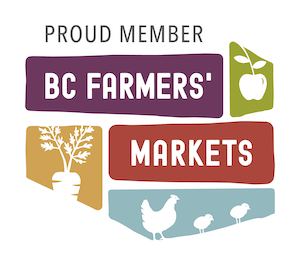The ALR needs you!

Have you heard people talking about the Agricultural Land Reserve (ALR) recently? Did you know the provincial government has assembled a committee to hear feedback from the public? Do you know that if you’re a farmers market shopper, it has a direct impact on you?
The ALR is significantly important to local food production in British Columbia. Almost all Vancouver Farmers Markets farmers are growing food on ALR land. The future of farmers markets rests on a strong ALR as well since many new and emerging farmers will need to be able to access viable farmland in order to grow food for us city folk.
Deadline for feedback is April 30, 2018. We would like to encourage you to join us and let the committee know why the ALR is important to you!
Still not sure what to say?
We came across this backgrounder from Dr. Art Bomke recently (thanks SPEC!) and hope it helps you figure out what issues you are particularly concerned about and how you can add your voice to the thousands of British Columbians who are standing up for local food and agriculture.
ALR/ALC Consultation: Possible talking points
Dr. Art Bomke
April 2018
Background:
British Columbia’s Agricultural Land Reserves (ALR) serve to preserve and protect good quality agricultural land in the provincial interest of current and future citizens. The Provincial Agricultural Land Commission (ALC) is an independent administrative tribunal dedicated to preserving agricultural land and encouraging farming in British Columbia. Despite legislative changes over the 45 years since the establishment of the ALR/ALC this is arguably the most effective system for protecting agricultural land in North America.
The current government of BC has established an independent committee to lead a public engagement process and provide recommendations to the government for our ideas on how to revitalize the ALR and the ALC. Start your participation by filling out this survey or sending a letter to ALR_ALCRevitalization@gov.
bc.ca or to Minister’s Advisory Committee
Revitalization of ALR and ALC
C/o Ministry of Agriculture
PO Box 9120
Stn. Prov. Govt.
Victoria BC V8W 9B4The deadline for submissions is April 30. Some possible talking points include the following, but please feel free to focus on specific issues that you feel strongly about and to put forward your own opinions.
Provincial interest:
Less than 5% of the land area of BC is capable of food production and given the looming pressures of climate change and global population growth, the security and resilience of our provincial food system depends on retaining as much of our agricultural land as possible. The ALR is science-based and is firmly grounded in our understanding of soils, climate and topography determinants of the land’s capability to support food production.
The biggest threat to the integrity of the ALR is the cumulative impact of public decisions regarding infrastructure development, as exemplified by the loss of high capability land to the Site C Dam, transportation projects and port development. Clearly, a strong mandate and voice are needed to advocate for the retention of farmland and this is most effectively delivered by a central body like the ALC, operating with a province-wide perspective.
Recommendations:
- Return to a uniform, BC wide process of decision making by the Provincial ALC.
- Eliminate the two-zone system that currently treats land use decisions in southwestern BC differently from the rest of the province.
- Eliminate the inefficient regional panels from the decision-making process.
- Empower the ALC to defend farmland in assessment of the impacts of major projects.
Lower Mainland Problems:
SPEC is acutely aware of critical land use issues on both sides of the ALR boundary in our local region. “Out of control” real estate prices threaten our ability to house and feed ourselves. Specific legislative or regulative changes in the Vancouver region are required to:
- Increase the incentive for ALR land owners to commit to sustainable farming on their properties, including reasonable security of tenure.
- Provide better support for small scale farmers, especially new entrants to farming, including access to more information and expert advice to help solve site-specific management challenges and to reassure landowners that their land is being cared for in an environmentally responsible manner.
- Set a maximum house size and non-farm footprint to reduce the impact of megahouse estates on productive farmland.
- Clarify and strengthen the regulations, monitoring and enforcement of dumping materials on farmland.
Encouraging Farming (Social Sustainability):
Encouraging farming has been one of the key directives of the ALC since its inception, however some of the tools used in the early days of the ALR are no longer affordable or effective. Working within budgetary constraints and today’s land ownership patterns, the BC and local governments should:
- Reward land owners who commit to sustainable farming and create opportunities for new entrants. Benefits would include considerations regarding taxation and participation in government cost sharing for farm improvements identified through environmental farm planning.
- Support a Cooperative Advisory Network of BCMAF, universities, Agriculture Canada, private sector, farmers and NGOs to provide more site-specific advice on water and soil management, crop protection, food safety and other farm management issues.
Benefits of diversity:
An ecological principle is that ecosystem stability benefits from diversity. This applies to agro-ecosystems and includes the benefits of diverse people and their land resources. The use of agricultural capability to classify agricultural land is the basis for the delineation of the ALRs and while the uniformity of the land is a prerequisite for large scale, industrial agriculture, this focus has devalued the benefits of a diverse land base enabling farmers to creatively produce a range of suitable products. It also fell short in recognizing the value of some lands to provide “non-farmed” food and medicinal products. In this light, we suggest:
- Lands with capability to produce “non-farmed” products be identified and given the protection afforded to high capability farmland.
- Recognition be given to First Nations’ need for land for culturally appropriate products and potential economic activity that could arise.
- The pool of new entrants to farming will draw from non-traditional sources including urbanites, First Nations, LGBTQ and youth in general and their potential contributions to the diversity and resilience of BC agriculture should be recognized and valued as we encourage new entrants in agroecosystems.




